#Human Factors
Explore tagged Tumblr posts
Note

The steel battalion controller could fix me. Some company needs to make specialty mech controllers so i dont have to spend £350 on 2003 hardware (so i can spend £350 on 2025 hardware).
Mech game Controllers: Solving the unsolvable
I have put so much time into thinking about this and you've basically asked the perfect question.
I think there are really complex and important questions that nobody really has a good robust answer to but also that nobody is really asking those big questions in the first place either, so we're stuck on this issue.
My take is I genuinely think if we want big mecha controllers we have to think about this stuff deeply and profoundly. Like, why we need them and what they're for.
So… This has been tried many times.
NOK or NextOfKin Creatives did try this.
The Mek-Fu lopped horribly, and I was absoloutely fascinated by this at the time and wanted to understand exactly why it had failed. I think we must learn from this failure, so we don't make the same mistakes again.
The lesson I took from Mek-Fu was this: it didn't take because players had nothing to use it in where it was the best fit.
What does this mean?
1) For other games in the real world, it was inferior to keyboard and mouse in games which do not simulate a vehicle. 2) The design wasn't trying to meet some sort of pre-existing need from other games. 3) Steel Battalion emulation did not exist meaningfully yet, and in turn no equivalent game existed on the PC platform which would need it.
Therefor: There was no special environment where its employment made the best sense.
It had nowhere to excel and thrive.
So where have specialty controllers existed, and thrived?
Digital Combat Sim (DCS)
Star Citizen
Euro Truck Simulator
Farming Simulator
What do they all have in common?
They all have robust modding tools for user-created content
They all have some form of social experience or multiplayer
They all are highly accessible (PC, and are controller agnostic*)
They are all sandboxes in some capacity and let users find their own fun.
No mech game which exists at time of writing meets all these terms that I know of.
So what do these controllers look like?
In the case of real vehicles, you can simply ape the real vehicle 1:1, but for fictional vehicles, something special happens -- you see people approach and try to solve the problem in many different ways.
You see, control design in any area exists to solve a problem. The Mek Fu (a response to the VT controller) was a solution looking for a problem, and no problem existed.
From this, we learn that for specialty mech controllers to exist, you first need specialty mech games. Steel Battallion is limited, because it won't run on general hardware and doesn't network or mod easily so it isn't a good fit for this because it makes the game inaccessible and limited.
Let's actually think about the SB controller for a bit:
Steel Battalion approaches its problem from the standpoint of a robot. You might not realize this but a VT or Vertical Tank intentionally controls very similarly to a tractor.
It is influenced by a real thing. I know that sounds absurd, but let me show you what a modern tractor's task control console looks like:
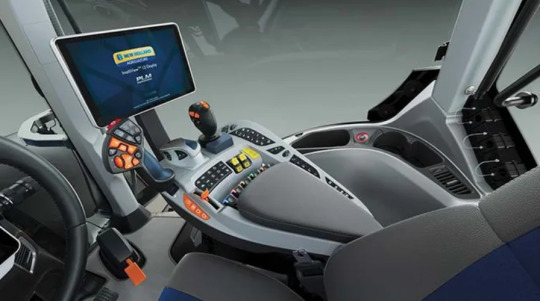
Yeah, not what any of us would have expected.
If you wanna be a mech pilot in 2025, go drive a tractor. I'm not kidding.
Once you're on the field, your hands aren't on the wheel, they're on this thing:
The big stick controls the course in the computer, the little one controls your tool, the many buttons toggle states (or what the little stick is currently triggering) and through these inputs you drive the tractor.
Steel Battalion is very fun, but it won't hold your attention for more than around 100 hours unless you're a real freak about tractors and just don't know it yet.
What's more, Steel Batallion isn't playable to anybody without the controller which limits how many people will be playing it and it isn't social or moddable like the successful games we talked about earlier.
Okay, so what can we do about this?
I think the one feature here that nobody talks about is that of input-agnosticism: The ability to bind your own inputs to something in the game (directly or indirectly through some middle thing) and get good results… But not in some hugely "okay bind 100 things using our controller, or use a keyboard and mouse" binary.
The binary is still not input-agnosticism, and it still will not work.
It has to be granular.
Input agnosticism results in controller agnosticism:
You can bind as much or as little as you want, and you can pass features you don't want to bind directly to a helper subsystem middle-man like an assistant or instructor which will perform limited tasks for you - while you provide the helpers context by telling them which of a limited set of goals you want to achieve.
Say, face a target, or a direction, or aim at a thing. It saves you mental time, though if you did it manually you might get better results (incentivising you towards experimenting in that direction).
Let's touch on why controller agnostic design is really what's needed here, and why its important:
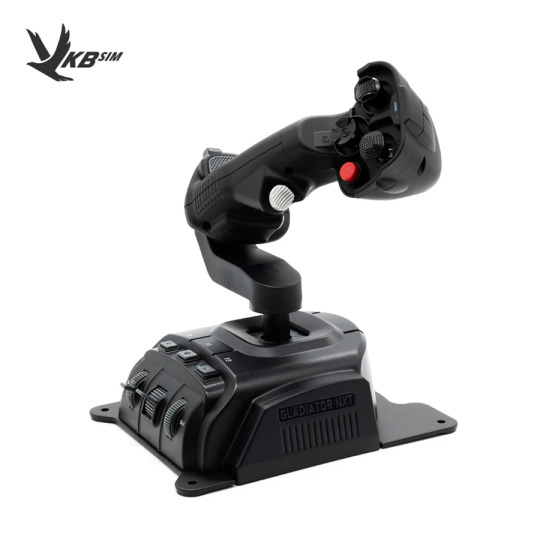
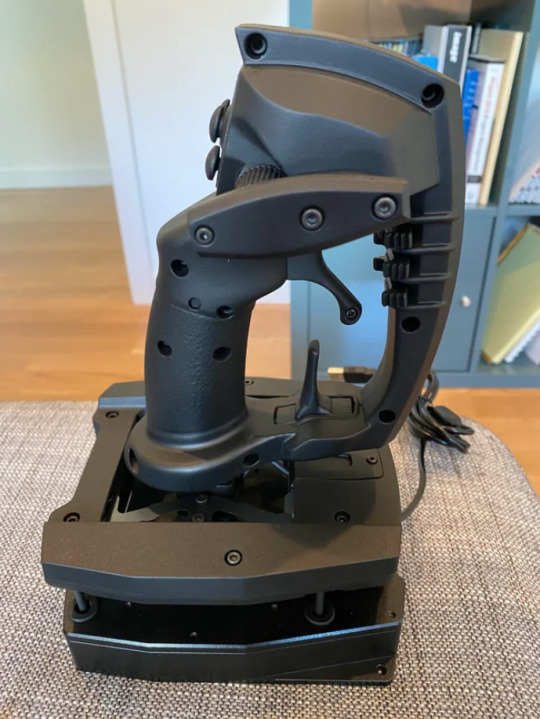
This is the omnithrottle, and and this is the Sublight Dynamics 6dof joystick.
The Omnithrottle tries to solve 6dof throttle management by adding an extra piece to a joystick at the bottom, turning the yaw z-axis-twist of the stick into a sort of vertical axis for direct up and down movement, ascending and descending.
The Sublight Dynamics 6dof joystick combines all six axis into a single device, and is an interesting experiment. I particularly like the puck switches ahead of the user's fingers, inspired likely by Evangelion which in turn was inspired by Sol Bianca's use of them.
We got great lessons in human factors for space dogfighting from both:
The omnithrottle produces huge fatigue if you use it in coupled mode (software assisted flight), because you have to hold the joystick base forward, fighting the springs. This is fine in decoupled mode (where you coast under newtonian force) but not everybody uses it. Likewise, if you remove that spring, you lose fine movement because you can no longer feel where the middle is anymore.
The SD6DOF creates a conflict in Fitt's law (speed and precision are enemies of each-other, and to get both you need a tool in the middle to help you) where some precision is lost due to the same muscles needing to drive more axis at once.
These are both many years old now, and over time we've seen many many solutions to this problem flop.
Well, VKB announced the Space Throttle Grip a few days ago, which rethinks the distribution of axis and combines the best features of both.
youtube
The key thing is, this is an evolutionary space with competing ideas. A healthy ecosystem.
And its only possible because the game's inputs are controller agnostic.
This doesn't just mean that it'll let you bind any input device directly to things, but that there are multiple ways to achieve your desired outcomes even on the software side with the helper middleman we talked about (in this case, coupling modes).
Does your machine turn to face an arbitrary vector which is the thing you actually steer or select (Warthunder)? Do you have direct input control? Do you haven an autopilot?
Here's a lecture by F22 Raptor test-pilot Randy Gordon talking about some of this stuff, giving you a frame of reference with a real vehicle which exists.
youtube
When you can pick between those goals them, you have what's called "a software" in human factors. Your two grips become arbitrary and are now called inceptors.
The software drives the machine, and you drive the software. You can override the software and provide a manual input, but the other elements you are not overriding will try to compensate to maintain a desired state. If you know how to manipulate this, it means you only need a small number of axis to achieve a very complex control action.
A great example is how long you hold the A-button in Mario changes how much power his jump has. The action is a versatile verb.
Imagine a person balancing. If their goal is to stay upright, and I push them, they translate across the ground and try to stay the right way up, turning that push force into horizontal force. They are following an instruction: remain upright.
If I make that person carry a very heavy thing, they compensate their body's balance accordingly. If I then use my finger and tell them to act as if I am pushing them with that gentle motion, they will respond but if they go too far they can say "hey, don't do that, I'll drop the heavy thing!" and ignore my pushing instruction -- because my directive telling them to remain upright superseded it.
We need to think of mecha in terms like these, and to do mecha, we need to make a standard of accessible rules like this which input devices can talk to via axis and buttons, with lots of middlemen.
Absolute (mouse-like) and relative (stick like) and accumiulated (driving a mouse with a stick by having a variable over time) and blended (driving a car with a d-pad with a simulated wheel that wants to return to zero all the time, replicating a stick) inputs must be middle-modes processing and digesting inputs in these ways. Curves matter. Biases and preferences must be accounted for.
This means finally solving "how" the giant robot works in software (even if its a design conceit), and then having systems which poke at the "how" to bias it in a direction toward an outcome.
My favourite version of this is a deliberately clumsy mech-game called Robot Alchemic Drive (RAD for short).
youtube
Playable on a regular PS2 controller, the triggers and bumpers drive the legs like a tank. The sticks drive the arms.
The robot's body has physics. You are controlling a thing.
There are no helpers to correct your motions other than when the robot stands up and to keep it upright (its otherwise 100% manual, playing back motion planning which gets fed into the physics) but yes, there is a simulated body here.
With helpers, this could get faster and way, way more fluent.
So how might these "helpers" in software work?
Think for example of how a body in motion continues to move. With a robot in a vacuum like space, you'd continue indefinitely. That's hard to control.
Do you automatically slow down and fake aerodynamic drag axially with your boosters to allow curved trajectories and soft stopping with a motion-control-decoupling-mode (as Star Citizen does), or do you have a breaking system a user can activate on a pedal or trigger, to apply those forces on different axis when they want them?
youtube
What are those axis bound to, the pelvis, the thorax, the head, the synthetic vision 3rd person camera?
These are really complicated questions, and this is just about how we make a vehicle come to a stop!
Now this might seem niche, but this exact same kind of thought also applies to how a robot balances, and how it digs its feet into the ground, creating torque or not situationally.
This isn't just fine grained motion like "moving our legs manually", but how and when we apply breaking force on the ground.
Do we apply it when we let go of the left stick?
Does the left stick prescribe a preferred velocity?
Does it prescribe input forces?
Do we change between these situationally, or maybe with a button?
Its important to think about these things.
"You're making this too complex!!"
"But why would we do this? What is the value? People are playing Armored Core 6 with a HOTAS!!"
Yeah, and that experience is not great, actually?
youtube
You're actually less capable than a keyboard and mouse-player, because Armored Core 6 isn't a game which simulates orientation over time (the body turns instantly as if by magic), so you're just driving relative inputs. You are literally disadvantaged.
Armored Core 6 has no "vehicle": This is an action-game's 3rd person control software. Its Elden Ring's horse, with a jetpack, and the roll replaced with a dash. Everything else is animations.
Its visually impressive, but there's something fundamentally missing:
Fahrvergnügen.
It means "driving pleasure" in German.
The feeling you get when you speed up going down hill, or you feel the give of the wheels against the road and the lean of the car when you take a corner.
When you bank against air in an aircraft, or turn faster than your velocity changes and you drift.
That good feeling, that's fahrvergnügen.
A game which really gets this I think is Armored Core: For Answer. I know many of you might have expected Mechwarrior here but the physics of Mechwarrior games are extremely simple, following an interpolative model.
youtube
Interpolative here means, a bit of calculus is used to ensure a smooth arching curve is how you go from zero to a high speed at all times, or a rotation, so on and so forth. This "smoothness" is the same smoothness present in Armored Core 6.
Armored Core For Answer on the other hand, is additive in how it calculates velocity per second, meaning your AC's velocity curve is inconsistent. The game has hidden stats calculating aerodynamic drag per part, it has a simplified model of angular momentum, and it has ground friction and its boosting system is different on each axis.
All of your inputs are analogue, including the angle of your boosters on left stick, and two booster-types: Your main booster handling like a motor-cycle throttle curve, and the other not only having many stages of output for flashes of thrust via contexts (combining motion and direction together to produce an intent) but also combos and even cancels. Its VERY sophisticated!
That's a lot of different factors to control. A lot of fahrvergnügen to be experienced when you master them, and feel ownership of them.
Lots of areas for skill expression.
This, combined with a rich weapon balance and a complex combat geometry (the emergent spatial and pressure rules of motion, aspects, angles and motions similar to the aircraft dogfighting) are why people are still playing this game today.
The match I uploaded was from four days ago, as of time of writing. People are still modding a game from 2008, limited to console by hacking the rom file's patches. Yeah.
I know among many game reviewers, "smooth" and "smoothness" is considered a compliment in game design (its easy to control), but interpolative motion really is the opposite of fahrvergnügen:
Interpolative suffers from feeling "zippy" and "hollow" when its fast, which is why lots of players and designers insist on slowing games down so they recover their fahrvergnügen.
You don't have to do things this way. A good mech sandbox should reward both fast and slow movement in its design!
There should be room for everybody to play!
In interpolative movement games, motion is already solved, to sell you the superficial power-fantasy (that you're good, despite not having learned how to be good) instead of giving you the experience.
Interpolation is insisting the burger you got at McDonalds is the same as the burger on the commercial. Like the burger at McDonalds, its also way way easier to make, and in today's market yeah, you take what's easy and known because you have economic pressures to get things done quickly.
You can't make a five star meal in a McDonalds kitchen, and the AAA games industry is the McDonalds kitchen of gaming.
So, what is a three star michelin meal, in terms of inputs, with additive movement?
You incentivise people with the cheaper stuff on the menu. That's robust helper tools which let keyboard and mouse players, or gamepads interact fluently.
Its affordable, and easy and gets people invested in your experience.
Then when people use fancy controllers, you get better response-rate. Because everybody buys into the mecha fantasy when they play, being beaten by someone who is controlling more complex control factors more directly at once (making them a better pilot) feels fairer.
They are negotiating the machine's limits better than you are.
You both know they more "an char" than you are:
youtube
It becomes aspirational, rather than annoying, which is how the culture of space-simming, and flight-sims, and other vehicle sims express this. It also fits the mecha fantasy, because those with basic controls are your grunt units.
We see this if we look at cockpit controls in Gundam: A Jegan's control inceptor is way simpler than say, Unicorn's.
It is just part of the fantasy.
So let's talk about these limits we negotiate.
It means, some kind of vehicle must be simulated in software, even if its a very simple abstraction purely enough so it feels good for players.
Also, I say "a software" or "helpers" what do I mean?
I don't just mean the simulated vehicle, but a robust modular middle system in the "player controller" part of the game simulation which interprets desired outcomes from a pilot user or operator and tries to achieve them.
Here's an example, let's talk about Armored Core's lockon system, which uses a software stack to turn your intention into an outcome in exactly this way.
Your robot's simulated sensors (radar, visual, etc) detects a list of potential targets…
Which uses camera orientation of a synthetic vision system to give you comprehensive 3d awareness to determine which target is interesting to you…
After selecting the target, it passes that information to the fire control system which computes a trajectory from its position and velocity…
This then talks to your weapons which know how fast your bullets go…
and this picks where to lead along that trajectory…
then that location is sent to the arms to execute that command…
Which then sends the state of this command chain to your HUD, so you understand what the body of your robot is currently trying to achieve.
Each step is influenced by ingame statistics and simulated mechanical limits -- meaning, how well you can lock up, or even select a target is very important.
You can't instantly put a cursor on something and bot a game, because everybody already has a deliberately limited aimbot, it came with your robot, to negotiate its deliberately limited body.
The key thing is, this is much much faster and more effective than you could as a human select the target manually and hit accurate than you could with round velocities -- with most videogames hiding this with hitscan (instantaneous bullet) weapons meaning whatever you click on is hit right away.
When the round takes time to get there, things are far more difficult. This is why almost nobody uses manual aiming unless they're throwing explosives at big bulky targets in AC.
From limitations like this, booster performance, turn-rate, and so on and so forth -- the negotiation of limits produces a combat geometry and how well you understand that combat geometry, and how well you understand your abilities to your opponents abilities dictates how the fight will go.
We see something somewhat similar in Steel Batallion with the lockon system but we also have a lot of deep manual control over our VT's orientations which change its balance and so on. Steel Batallion is in fact, one of the few games where your robot can fall over and get back up.
This is exactly how DCS and Star Citizen also work, and very similar principles apply in Eurotruck Simulator and Farming Simulator via the fuel, cooling, air, combustion cycle, and transmission, and shock absorbsion systems of your vehicle.
Okay, so now what?
I've been thinking for a while now about writing what I think would be the mech-game equivalent of the paper Tim Berners Lee wrote for the web (Information Management: A proposal) going into what I think the simulation would really need, what the software would need, what the controller would need and some suggested practical strategies for solving these problems based in real research I and others have done.
The system I've already built solves for fire control, fine arm motion, head movement, independent pelvis and foot motion, the operation of boosters and other similar systems in a 6dof environment which accounts for gravity, aerodynamics, balancing, alignment and full motion control -- all on a standard game controller. Its not modular yet, simply because I am not a skilled programmer, and would need real help to do this.
There's also game-design research here, which would ensure the combat geometry would reward skill expression via investing in that agnostic game design, so the control skill aligns with the power-fantasy through skill expression. This means no one strategy becomes overwhelming.
It likewise, also has the "for gamepad and keyboard/mouse" solve which would be needed to ensure its accessible for those who aren't ready yet for custom controllers.
In turn, it also has considerations and proposals for such likely controller designs and probable strategies of employment which of course translate and map to two big sticks, in a HOSAS (Hands on Stick and Stick) layout.
So what's your ideal controller?
Less a controller, and more a principle:
Key to the proposal is you can scale up the amount of control bindings, or scale it down passing automation to helper subsystems which take your intention and act on it in a useful way.
You could have just two plain sticks with foot pedals, or you could go ham and have some complex force feedback device with tons of inputs -- because of this input agnosticism.
The secret sauce I think to the highest end control is the use of software defined force-feedback not only for the two big sticks, but also four smaller ones: one each for your thumb, and one each for your finger on each hand, and an analogue trigger. I've seen this solved in open source projects, so its entirely doable.
What does this actually mean?

Source: KAIST-HCIL/FS-Pad
The purpose of a force-feedback stick is software defined -- driving the camera, pelvis, upper body, boosters, walking etc variably, with the feedback not necessarily telling you about the environment -- but also by providing what amounts to new input devices.
To explain, force feedback works by providing input to the stick like a robot arm and is not at all like a rumble feedback device. This means the position the stick "wants to return to" at any given time is not defined by springs like it is in a conventional controller, but by active software which can update in real-time.
This means resistance can be different in different directions, or the stick can even hold a position you give it in one axis but not another, replicating a hat switch or a flight throttle.
I've looked at many different open source projects which achieve these outcomes both on thumb-sticks and main sticks with great outcomes, and I think a prototype could be made if I had a team, or other people to work with.
If interest is expressed, I'll produce a specification proposal for what this input agnostic design in software needs to be (eg, how the robot is controlling) in strictly defined terms which can be implemented.
You can already see it on my Tumblr account as TOMINO, NAGANO, etc where I go into some of this -- all of which works on a standard controller, but adapts extremely well to a large HOSAS.
Likewise, I'd (eventually) also produce a proposal for a controller design which meets this specification.
I've been testing this concept on and off for many years now in Unreal Engine (I'm not a skilled programmer, not skilled with CAD or electronics, depression limits my effective outcome returns -- but I'm still getting very promising outcomes).
Ultimately what I'd really want access to is expertise and help, since my background is mainly thinking about and designing solutions for problems not necessarily implementing them -- and I'm essentially on disability, so I have unlimited time to think about this.
I don't want to ask for money, which I figure is the thing everybody is anticipating: I'd rather get this done than make money from it.
In conclusion?
To solve this what's needed isn't some figure of brilliance in a basement or garage somewhere, but an organic ecosystem of designers and builders responding to pressures, and we've already see that work many times very well.
In our case, nobody has defined the vehicle or the modular helpers in a way robust enough to capture every fantasy effectively.
That's the issue.
tl;dr coming away from this:
For the controller to exist, you first must have something to control.
To be a pilot, you first need a vehicle.
--
Live forever, Apes.
#.AskOsaka#Mecha#Mech#Mech Design#Game Design#Peripheral Design#Peripheral Concepting#human factors engineering#Human Factors#Scifi
105 notes
·
View notes
Text
Hi! I'm...

daytura, he/him, a 22 y.o. cognitive science major @ (UC) Santa Cruz, CA.
I am interested in...
Building a next-gen theory of cognition
Ergonomic design that puts the human back into the machine
Improving my memory, attention, and social skills
Sitcoms (1960s-1990s), creative and technical writing, casual gaming, and photography
I am not interested in...
Banal discourse, drama, and vitriol
Chronic sneering (we're all cringe here)
Absolutes, lack of nuance
You should also know...
Current self-posts are under the "morning mail" tag -- older ones are under "homegrown by day" and "homegrown by postie"
I sometimes reblog to/from my conflict-theory era @roxytonic blog, but I'm now subscribed to the principle of functional differentiation per Niklas Luhmann's social systems theory
I used to be really interested in personal knowledge management (early 2021 to late 2022), Homestuck (mid 2016 to early 2023), Adventure Time (April 2020), consumer technology (2015-2021) -- feel free to ask about these topics
I'm available on Bluesky, a federated microblogging social network
I sometimes publish longerform to my archival Substack, "Across the heliotropes"
If you're in the Santa Cruz and/or South Bay Area, feel free to reach out!
5 notes
·
View notes
Text
I miss phones with real keyboards. They were very satisfying little buttons to push. And easier to text without looking.
2 notes
·
View notes
Text
but these aren't the same? In the first one, if you misjudge it, you can bounce off the sides and get back to the top. In the second one, one wrong move and you're done no matter how far you've come. That means your risk assessment is different.
What this is actually teaching is that superficially small changes can have a major impact on performance.
It also shows that people would rather comment on psychology of the individual than think about system design.
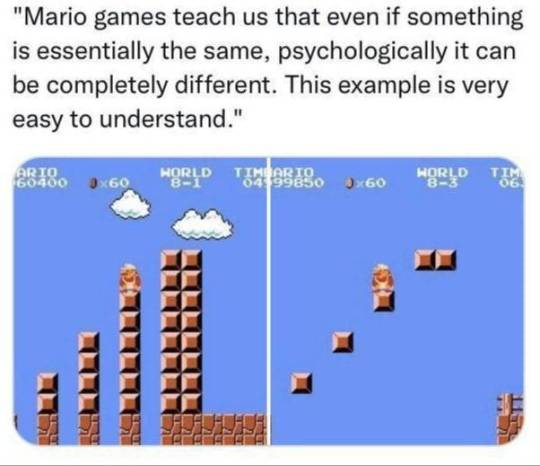
34K notes
·
View notes
Text
Job - Alert ✨

🚦 Job Opportunity: Research for Safer Roads!
Technische Universität Dresden is hiring a Research Associate / PhD Student / Postdoc (m/f/x) in Traffic and Transport Psychology (E13 TV-L, 75%) starting July 1, 2025.
Join the EU project Roads4All to explore safety culture, develop impactful interventions, and conduct innovative studies – including VR experiments and international collaboration.
🎓 Requirements: Degree in Psychology, Human Factors, or related field, strong quantitative research skills, motivation for research, and good English proficiency.
📅 Apply by June 4, 2025
🔗 More infos and apply: https://www.academiceurope.com/job/?id=7613
0 notes
Text
Cool resource to see real condensed cases of human factors.
1 note
·
View note
Text
Neuroergonomia e human factors per migliorare il rapporto uomo-tecnologia e tener d’occhio l'attività cerebrale durante il lavoro?
0 notes
Text
Podcast - Bad Behaviour in Teams with Liz Crowe at Tactical Trauma 2024
As healthcare professionals, we often pride ourselves on being part of high-performing teams. We work under immense pressure, striving for excellence in environments where even the smallest misstep can have life-altering consequences. Yet, amidst the chaos, there’s a subtle, insidious force that can undermine our efforts: bad behaviour. From an eye roll to a dismissive comment, these seemingly…
0 notes
Text




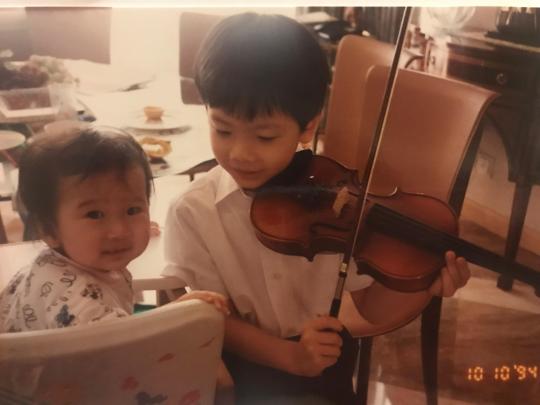




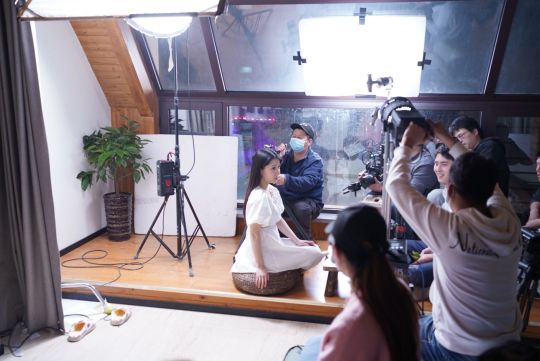

Does Her Family Background Affect Jocelyn Choi, A Good Actress? The 3 Pieces Of Advice That She Gives To Anyone Who Wants To Get Into The Acting Field?
We often cannot figure out the purpose of an unexplainable passion. In that way, passion is perhaps the purpose. When you love what you do and do it persistently, passion will become destiny. There will be no regret about a failure if it is for passion. Passion is not chasing a rush. Passion is also not necessarily about making it to the finish line.
The young actress in Hong Kong Jocelyn Choi (蔡頌思) told me, “I don’t know what I will ultimately look right. Right now, I enjoy acting and sacrifice for it without hesitation.” Jocelyn is the daughter of my senior alumna in Law School Janice Kwan and I run into her regularly since we both love art. Jocelyn’s father is the very well-known businessman in Hong Kong Mr Choi Koon Shum (蔡冠深).
Jocelyn has one elder brother and 3 younger brothers. Apart from her good family background, good education is one thing that no one can take away from her. She studied in the prestigious St Paul’s Co-educational College and completed a degree in English from the Chinese University of Hong Kong. She got an offer to further pursue drama education from the Hong Kong Academy for Performing Arts but Jocelyn suddenly got a job to act for the reputable Hong Kong Repertory Theatre. She gritted her teeth and bit the bullet: no more school! She thus entered the acting field.
Janice said helplessly to me, “I am sorry that our family background gave Jocelyn a hard time. People thought we pushed her to be a star. We financially invested in all her jobs. We were her domineering manager and she took up the artist position just for fun. These are absolutely misunderstanding. In fact, Jocelyn’s daddy was against the idea that she would become an actress! God creates boys and girls who have a thing called free will!”
Jocelyn talks confidently and accurately, with a pair of clever eyes looking for the right words to say. I can feel she is a sensitive artist who can be very perceptive. If not being an actress, she could be an able business executive.
She articulated, “The advantage of being in an affluent family is that I don’t have to take money back home. I am given free accommodation and food so that I can follow my dreams. I know it is a luxury but it is also the reason that I must work harder. I must stress I am who I am and should not let my family background affect my chances for success. My passion in acting started during university days. I studied English literature and had many opportunities to take part in drama productions. Drama unlocked myself—my abilities, my creativity and my courage. I became determined to be a performing artist. After leaving university, I search online the invitations for audition and such pursuit was almost non-stop. I luckily found acting jobs one after another though tides could be high and low for me. I build up my career gradually. Gosh! I am still struggling and will not give up!”
I switched to another topic and asked, “Do you have any advice for a young girl who wants to act?” Jocelyn expressed her view, “Being an amateur actor is good fun. The real world is different. Entertainment business is extremely competitive and there are too many complicated human factors beyond our control. Frustrations can make you doubt yourself and cause depression. Always be positive and have high emotional intelligence. Tune in to what is facing you. Forget ungrounded criticism against you as dissing also brings ungrounded fear. When you believe you have reasoned reasonably, abide by your belief and make progress by keeping on trying!”
She added a second point, “Luck is a shortform answer for ‘I have tried my best but cannot reach there’. As an actor, you must have talent, sacrifice a lot of time and are tortured by numerous uncertainties. Luck and destiny should not be the excuses for personal inaction. Luck is where opportunities meet your hard work and readiness. So, I incessantly asked people to give me opportunities of an audition so that I would prove to them that I might fit the role. I don’t feel anything like losing face. In life, there are bound to be someone more fortunate than me.”
Jocelyn was still eating slowly her tiny bowl of soup, probably for weight control because we all think a good-looking actress must be slim. I would never forget the last thing that she said to me, “An actress should not be shy! I am shy in my own way and trying to overcome it. In the entertainment world, you need to try to be what you are not, sometimes. Try to explode like a volcano when people are around you and you must make them cheerful. In our profession, people and reporters usually like socially aggressive and pleasurable girls. Acting opportunity is often about initial connections and cultivating them over time. Again, I am learning from other good ones who can closely check in with their contacts, whether through telephone messages or gatherings, to show that they value the relationship with these people who can help them. Since I don’t change my goals, I can only adjust my style of getting along with others!”
Making conversation with Jocelyn is enjoyable because she gives short and clear answers. Our fast-paced life has made junk foods a part of our lives. But, fast-paced conversations were wonderful because after I sat down to lunch, I suddenly found out that our happy time ended—albeit reluctantly. When young, do indulge in the exploits of youth, as this is a one-time luxury of everyone.
Maurice Lee
Chinese Version 中文版: https://www.patreon.com/posts/cai-guan-shen-nu-103075592?utm_medium=clipboard_copy&utm_source=copyLink&utm_campaign=postshare_creator&utm_content=join_link
Jocelyn Choi Official Music Video
youtube
Acknowledgement-Jocelyn Choi
Jocelyn Choi Official Music Video
youtube
Acknowledgement – Jocelyn Choi
VE Channel Guest - Jocelyn Choi
youtube
Acknowledgement-VE Channel
0 notes
Text
Hi, I'm Osaka
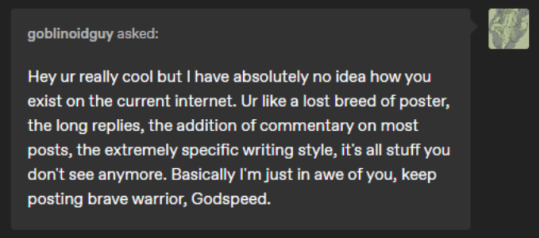
I'm a hobbyist designer, and I research esoteric concepts on the periphery of mecha to find new views nobody else is writing about. I also am obsesed with trying to push the genre forwards.
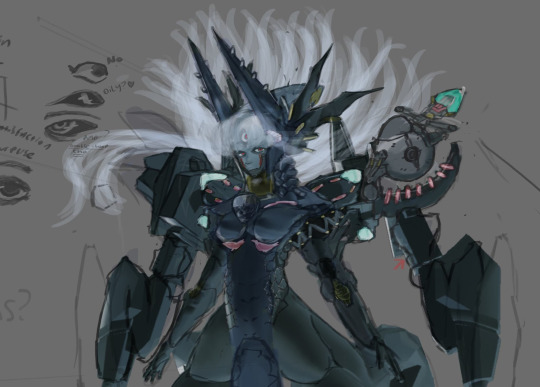
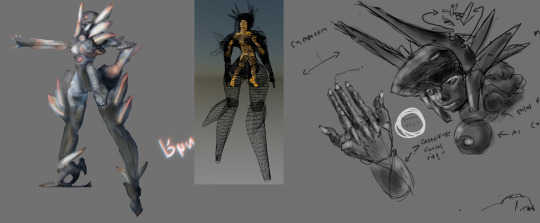

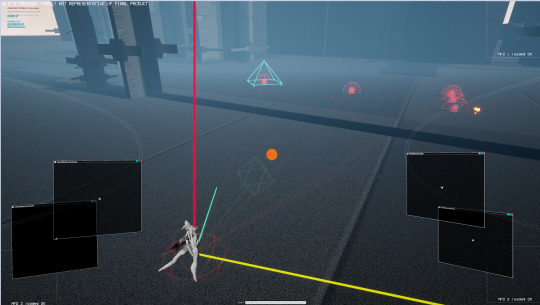
I also took up programming to build a game faster than ACFA, more airborne than Ace Combat, and more "art of the blade" than Zone of the Enders 2 by studying mecha games through the lens of published declassified military grade airwar and psywar human factors engineering and psychology concepts.
I want to make this game about mechposting and the trans experience, but I need your help: not money, but to speak with you about mecha.
The writing is simultaniously equal parts thesis to microfic a lot of the time, so your milage may vary.
Scroll through the mess below and find what suits you best.
Please.
Mecha Theory Writing
A comprehensive explanation of the evolutionary path from conventional ground and air vehicles, including a comprehensive outline of a functioning control-design based on the inceptor/software model seen in unmanned drones and 5th gen aircraft, complete with explanations.
The evolution of the walking thing called “mecha" (original)
Chapter 0: Establishing terminology & Concepts Part 1: Defining "the mechaness" of something: the 8 principles of mecha Part 2: Feisability: Mecha aren't realistic, but not for the reason you think
Chapter 1: How does "mecha" come into existence/why would you want one? Part 1: An evolution from ground vehicles of today Part 2: Skating, to walking, to running, to flight Part 3: “Why transform in the vacuum of space?”
Chapter 2: Cockpit & Software Design Control Theory Part 4: On Mecha Control Theory: Considerations Part 4a: On Mecha Control Theory II: OKAWARA Part 4b: On Mecha Control Theory III: TOMINO Part 4c: On Mecha Control Theory III: NAGANO
The World of Armored Core
An exploration of the world of Armored Core, using research into real phenomenon and engineering systems to infer how the world may itself function
Kojima particle physics (part 1): What are they? Kojima particle physics (part 2): The Human Consequences NEXT cockpit design (part 1): AMS and Lynx NEXT Cockpit Design (Part 2): G-force Tolerance Technocrat is SpaceX, and the legacy of Musk’s father (lmao) I am a 4th gen douchebag, and I love it (love-letter to ACFA) 4th gen shitpost: white gopnik
How To Domesticate Your Pilot
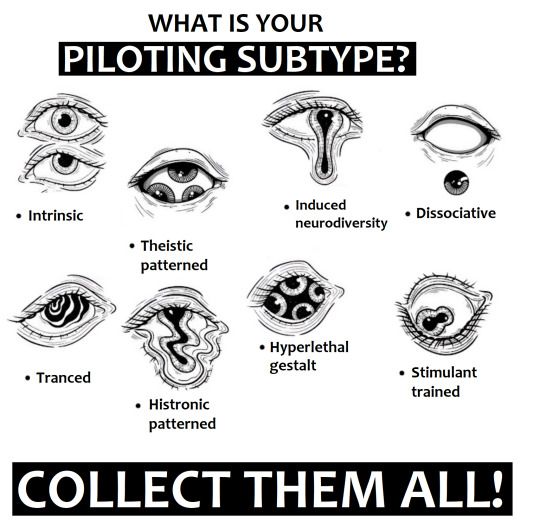
A husbandry guide for handlers, consisting of opinions and thoughts from various trainers and operators, as well as pilots. Includes practices, procedures, articles, stories and snippets.
I'm currently testing the waters with snippets and will likely be posting it out of order. I am extremely hungry for any and all possible feedback
If anybody knows the original source of the image of the eyes (which I first saw in a youtube ad) I'd love to know. I very much would like to commission them.
Inspired by mechposting
Chapter 3: Do not Abuse Your Wolves (Psychological patterning) Part 1: Action patterning (Initial Phases) Part 2: Action Patterning (Risks) Part 3: Once upon a mechanism
On mecha design: My personal thoughts on the assemblies of shape, form in the context of motion, action and function 1. Does anybody else have physical characteristics they find the most appealing? 2. Thoughts on self-altering dynamic form, and proportion designs 3. Shoji Kawamori and Armored Core: designers hallucinate, but do they hallucinate too? 4. Why is Gundam Gquuuuux called Gundam Gquuuuux?
Mechsploitation thoughts

#Mechposting
My personal thoughts on piloting culture, and mechanical design
1. The eroticism of the machine: Megastructures 2. Beyond pilebunker: The Grind-blade and the legacy of Overweapons 3. FLAT/Touchscreens are an act of hate: I will teach you love 4. You do not need to pick between a big hammer or daggers if you are a robot 5. O'Socks combat mix (tw: substance abuse) 6. Team dynamics, addiction, conflicts of interest and marketing 7. Commuication is hard, and mecha feet are cool 8. Morrigan Aensland is mecha and you cannot change my mind 9. re: Last Exile is not dieselpunk; its post-steampunk deleuzian dreams 10. Mecha PMC promotion is back, in pog form 11. Bodies, corporeal schema, and the body language of pilots 12. The blessing of the hounds; main system engaging combat mode 13. Exotic doctrine: Grappling & Booster-fu // torsion, aspect and control 14. Osaka, why do you always want to talk about ACFA? 15. You walk, so they can run
# Miscposting: Immacullate vibe-topia Pilot, for you: Love. Love. The sound of the ideal cockpit Left Hand/Right hand [gone]-- Mechposting vibes soundwall 🇸🇮🇨🇰🇧🇪🇦🇹🇸 🇹🇴 🇸🇪🇪🇰 🇦🇳🇩 🇩🇪🇸🇹🇷🇴🇾 🇹🇴: A #mechposting playlist [ongoing] Cicatrix: A writing playlist Sounds for violence: Mecha games vs FPS games
# Pilotcore: Dress & attire 1. Attire concept (includes #mechposting patch list) 2. Crew attire for things other than piloting a giant robot 3. Singleton over-jacket 4. Radios, straps and whips 5. Wearable keyboard for pilots 6. What color should a flight-suit be? (#AskOsaka from @siveine)
The Learning Tree
Reading this will help you grow as a person, or ask questions
"I experience depression as a failure of resource allocation systems" Adult social skills 101, because the world broke our ability to understand eachother Mental health: Things I wish I knew in my teens, my 20's or even my early 30's Sex-positivity, associations, critical thinking & deradicalization Crossing the hrt libido event horizon without libido heat-death by making biscuits Fool!: Your nostalgia isn't real: Your past has been stolen from you! Why Linux diehards are morons, and so is everybody else too On the ecology of slurs and the evolution of language Individualism can mean many things. The three fetishes of the human condition The real meaning of "you will not be an anime girl, you'll be your mom"
Nothing, but content for contented malcontents
Insightful, but stupid.
The collapse of the anime ecology's biodiversity Cycles of Nostalgia: Nobody is going to be nostalgic for Corporate Memphis Europe doesn't teach the Odyssey: Americentricism's fetishism is already its downfall Feeling used: The eternal disappointment of the Sawano Drop Lame? Bitch please: Clubbing deserves to go extinct every pmdd transmasc is that badass hot painting of satan crying The reviewer made a major error The Maid's Paradox Bread real
The horrors
Robo ComBAT: Cactus Jaque (original)
The Fear
Concerning plunges into the ne plus ultra culture of tomorrow
Humbert complex: When people prefer what they imagine to what's really there White Diamond, fascism, projection, ego, how Steven Universe botched its end. Sandwich names: the internet sucks now and smartphones are to blame! Gatekeeping is weird and knowledge-checks are arbitrary nonsense "The internet feels gross now", a trajectory of human events Providing feedback is also a skill and not everybody has it. AI isn't evil but it does embolden the worst people economics is just twitter brain for worth Do you?
My actual projects:
Art (I'm kind of private about my output and don't post often, sorry)
Pixelart: A very silly computer design that makes me smile idk
Games:
Project Force: 6dof aerodynamic high speed robot action [ongoing] Inspired by Armored Core For Answer, Freespace 2, Zone of the Enders 2 & Ace Combat 3, this game aims to merge their elements into a high speed mech sim.
e: yeesh this pinned post is getting kinda huge, I should break it into sub-pages or something so nobody can ever see any of it lol
110 notes
·
View notes
Text

Who is this sassy lost child?
[First] Prev <–-> Next
#poorly drawn mdzs#mdzs#lan wangji#a-yuan#A-Yuan knows how to to utilise his big wet eyes to get treats. What a little legend.#The crowd comments about LWJ being 'daddy' and WWX being 'the mother' are a little too 'fan-service bait' for me.#So I am personally reimagining it as another layer of 'misinterpretation of a more complex situation' commentary.#I like how the different styles of interacting with children WWX an LWJ exhibit say so much about their own childhoods.#We - human beings in the real world - take two lessons from how we were parented: What we valued and what we wish we had.#LWJ leaning into indulgence is him pushing back against his own childhood of asceticism. It's something he didn't have - so he gives it.#WWX on the other hand has been *so* defined by his drive to indulge. And here he is the restrictor!#It takes a bit more to see what's going on here. The factors are not singular.#but to keep it in theme with LWJ; I'd propose it is partly his way of establishing structure when he did not have it as a child.#Both approches are a way of saying 'I didn't have this and I wish I did.'#With LWJ it's pretty obvious why...but WWX? What is at your core? What is your regret towards a lack of restriction?#Or...What benefit do you think it gives this child to learn the harsh lessons of going without?#Did it make you strong when you were a child? Do you think it is just the nature of the world and we all must learn it?#How we interact with children is such a fascinating topic to delve into our psychology and neuroses.#In a more light hearted turn of topic:#WWX confirmed to be 'person taking the car to the drive through to order one black coffee for himself' on the triangle spectrum.#LWJ is saying 'we have food at home' as he is opening his wallet ready to order for everyone.#(Technically this is comic 213 but yippee! We are in the 200's now! Thank you all so much for reading and cheering me on!)
2K notes
·
View notes
Text
girlblogging in a class that i have done no work for this week but still answer questions for extra credit
1 note
·
View note
Text
Oh I *like* this article, it gives sources for SEVENTEEN recorded cases of endometriosis in cis men! Absolutely fascinating. Look at this data!!!!
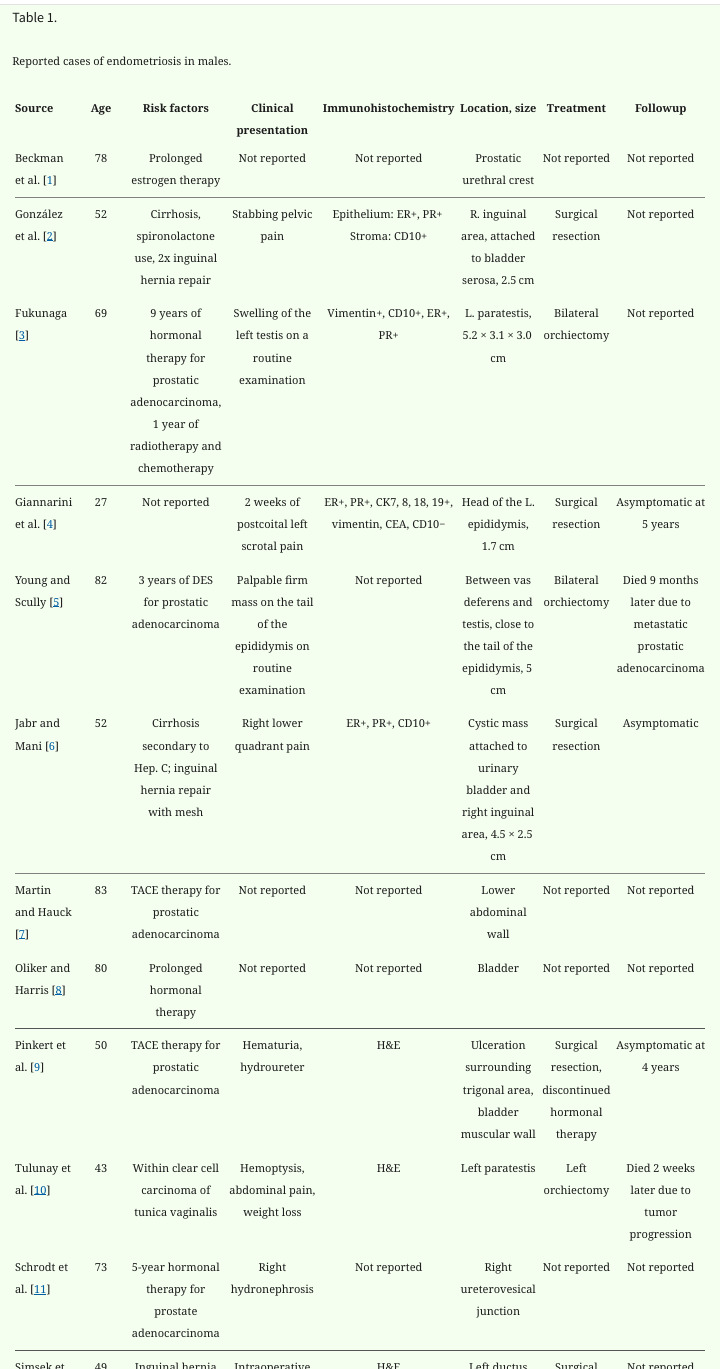
Absolutely FASCINATING ramifications for the fluidity of sexual characteristics and development!!! I knew there were a couple recorded cases, but this article links to 17 cases!!
#this is SUCH a handsome table too! risk factor and pathology and presentation and yes yes yes HANDSOME table#ohhhh i love biology. i LOVE biology. yes yes yes yes yes yes YES#humans are so fascinating!! absolutely fascinating.#oh i WISH trans health care would normalize enough to benefit from this sort of thing and to be included in it. and intersex health care#deserves to benefit from this too and be included! yknow i didnt read the entire article yet. maybe it mentions these things? its already#wowed me with SEVENTEEN sources for recorded cases so! i better go check!#sorenhoots#anatomy#biology
413 notes
·
View notes
Text
Basically, my philosophy around disability fakers is: I would rather a thousand people fake a disability than have one disabled person suffer without care, aids, compassion, or any help.
#disability#disability advocacy#and there's a difference not many people seem to recognize between faking and realizing you don't have [x] problem...#...such as realizing you don't have [x] disorder because it is instead [y] disorder...#...or you haven't completely understood your care needs/your symptoms/what helps you...#...and some people see ANY change in your understanding of your disability as proof of maliciously faking...#...when i suppose in my personal experience people don't *maliciously* fake disability...#...i'm not saying it could never happen but that i don't think it's the *only* thing motivating people called fakers#i just think (like most everything) this is complex and nuanced because it's a *human* experience#like for me personally i /know/ i still have a lot to learn about my disabilities...#...like... i realized recently that my hands shouldn't be in AGONY when warm water is ran over them when it's SLIGHTLY cold inside or out...#...and i realized that i likely have a Noticable limb difference that needs checking out. does this sound like i'm faking...#...or that maybe i just didn't really explore my own needs and body because of a variety of factors?#i can assure you it is because i haven't really thought before about how i deserved to understand how to best help myself
4K notes
·
View notes
Text

theres nothing behind those eyes. its just black void
#hermitcraft#hermitcraft season 10#grian#bdouble0100#grianmc#bdubs#hermitcraft fanart#did not intend for grian to not have detail in his ears but it just adds to the weird freak factor. he aint human#not ship but i also dgaf#from grians world tour yay i love that video
395 notes
·
View notes
Text

i think theoretically the idea of caine adding in some sort of pet would be very fun and cute but i cant help but think pomni would be unnerved by it
#tadc#the amazing digital circus#tadc pomni#my art#eyestrain#maybe. cus of pomni#she knows the npcs can be self aware but how does that translate when an npc is designed to be an animal?#does caine comprehend how self awareness feels in others? would he be able to comprehend how it feels for animals?#HUMANS even struggle with both of those particularly with animals. how would caine interpret that?#(i dont think she even knows hes an ai but factor that in. how would he?)#would it stop the cat from having the same degree of self awareness a standard npc could theoretically have?#what if it DOESNT?#these are thoughts i think pomni would have and theyd cause her a good amount of distress#i think shed find the cat sorta cute though. if existentially horrifying#pomni existential ocd haver. to me. btw
340 notes
·
View notes